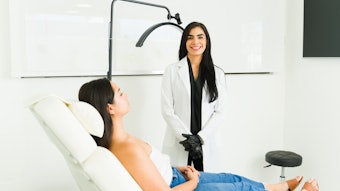
Is your spa getting more requests for anti-aging treatments by young women? How do you handle them? Read the information below for some guidance on how to communicate with younger clients who want to start looking into Botox and other anti-aging treatments.
Reality TV fixture Kim Kardashian may have raised a few (unfrozen) eyebrows with her recent admission that she’s already used Botox at age 30. But for some young women, the question seems to be, “What took you so long?”
“I wanted to be cute, to look cute, but I had these ugly lines in between my eyebrows and on my forehead,” says Stephanie Torres, 19, of New York. “So I asked if I could get Botox. My mom paid for it. It was like a little birthday present.” Torres, who went under the needle at age 18, is one of many teens and early 20somethings who are turning to Botox in an effort to not only smooth existing furrows, but fend off the aging process itself.
“We do a lot of Botox, and there’s definitely a propensity for younger people doing it,” says Dr. Glenn Vallecillos, a Beverly Hills plastic surgeon. “I’d say 30% of my clients are 20 to 25 years old and probably 5–8% are under age 20. The trend, at least at our offices, is younger people.”
Statistics also suggest Botox use is trickling down even younger. In 2009, the American Society for Aesthetic Plastic Surgery reported 12,110 Botox or Dysport (another wrinkle-relaxing shot) procedures performed on patients 18 and under (in 2008, the number was 8,194) while the American Society of Plastic Surgeons found 11,889 cosmetic Botox/Dysport procedures were performed on patients age 13 to 19 (an increase of 2 percent from 2008).
While smoothing wrinkles is just one of many uses of Botox (the toxin is also used to treat heavy sweating, crossed eyes, migraines and neurological disorders), recent reports of teens as young as 15 getting Botox have prompted organizations such as the Physician’s Coalition for Injectable Safety to come out against a “teen toxing trend.”
“I’ve heard from colleagues that kids are coming in with their moms and saying, ‘Can I have Botox, too? I feel like I need it,’” says Dr. Mark Jewell, a plastic surgeon from Eugene, Oregon, and spokesperson for the Coalition. “Botox is a blockbuster of a product, but should a teenager be getting it? I think the answer is no.”
Other practitioners, such as New York-based plastic surgeon Dr. Jeffrey Yager, say Botox can sometimes be beneficial in younger patients. “The great majority of people under 21 don’t need Botox, but there are some who do, and they shouldn’t be excluded just because of their age as long as they’re over 18 and understand the risks and benefits,” he says. “Each patient need needs to be properly evaluated—you can never say always or never.”
Jewell concedes that Botox “may be appropriate” for a teen if “there’s a convincing reason,” but is mainly worried teen toxing reports could lead to unsafe practices. “I think the biggest thing here is helping young people make good decisions,” he says.
But everybody’s doing it!
Torres, the 19-year-old who opted for Botox to erase the “squint lines” she saw after switching from glasses to contacts, says she and her friends don’t see anything wrong with cosmetic procedures, even at age 18. “We’re surrounded by it,” she says. “It’s in all the magazines, and all of my friends’ moms do Botox. If you’re really not happy with yourself and how you look, why not get it taken care of?”
The attitude that all flaws need to be “taken care of” is precisely the problem, says Roni Cohen-Sandler, a clinical psychologist and author of Trust Me, Mom – Everyone Else is Going! “I don’t know about the medical implications of the long-term use of Botox-like agents, but what disturbs me is the underlying preoccupation with youth and avoiding ‘imperfection,’” she says. “Are they so afraid of laugh lines or natural aging? They’re growing up with the mentality that there is a quick fix for not being ‘enough’ in every way, whether it’s Adderall to get better grades or surgery to change the size or shape of their breasts.”
But there can be extenuating circumstances, says Colleen Dozark, a 58-year-old billing manager from Omaha, Nebraska, whose daughter got Botox injections at age 16. “She had a terrible crease in the middle of her forehead,” she says. “[The Botox] wasn’t changing her looks in any way; it was more of a preventative measure to train her not to frown there. I only allowed it because it was such a severe crease for a young girl and it was kind of bothering her.”
But Cohen-Sandler says cosmetic “fixes” not only counter healthy messages—for example, telling girls it’s who they are and what they do that count, not what they look like, they also set young women up for a lifetime of costly procedures.
Injections for life?
Tracy Drumm, a 27-year-old marketing director from Chicago who first opted for Botox at age 19, says she’s continued to use it over the years as a way to shape her eyebrows (Botox gives them an arch) and fend off signs of aging.
“If you’re not using the muscles to create wrinkles in the first place, they’re not going to appear,” says Drumm, who estimates she’s had about 15 or 16 procedures so far. “Why would I stop if it’s going to help me prevent having wrinkles that I don’t want?”
But not everyone who’s used Botox at a young age is trying to stop the clock. “If it’s for a good reason, like a deep-set wrinkle, then I think it’s great,” says Dozark’s daughter Jessica Baldwin, now a 26-year-old health specialist from Fayetteville, N.C. “But if it’s just because you don’t want wrinkles, that’s tough. Because everybody ages, whether you want to or not.”
By Diane Mapes, MSNBC.com, June 28, 2010










